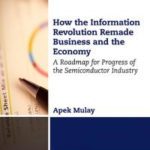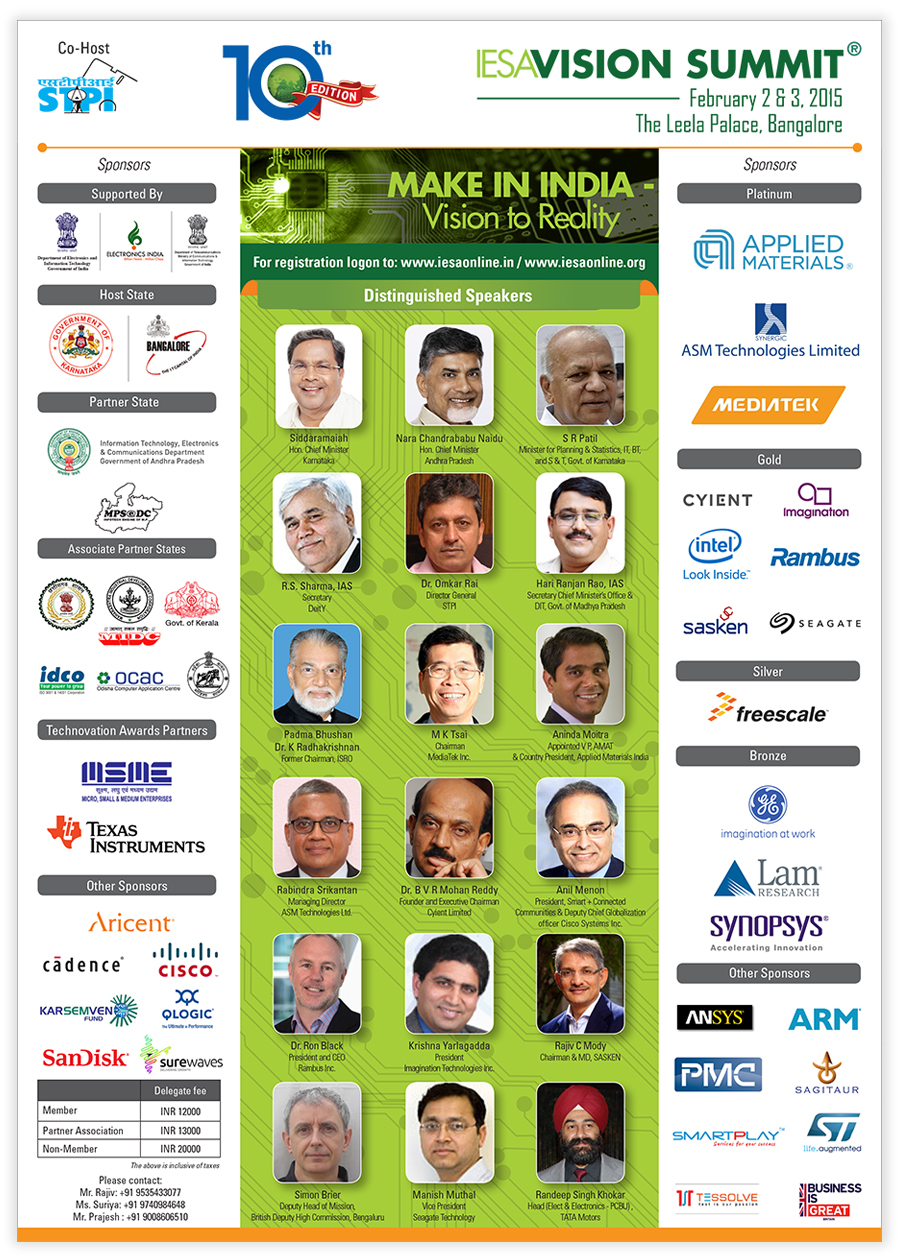This has been originally published on EBN
The 10th annual India Electronics and Semiconductor Association (IESA) Vision Summit brought together the stakeholders in Indian Semiconductor Industry in hopes of enhancing collaboration between industry, academia and government with an eye toward making the vision a reality for ESDM sector. Day two of this event started with an opening session on accelerating the ESDM ecosystem with chief minister of Chhattisgarh, Dr. Raman Singh as a notable guest. The chief minister’s presence at this event demonstrated the commitment of his state towards promoting ESDM ecosystem.
The Keynote speech was by Gururaj “Desh” Deshpande, President and Chairman, Sparta Group LLC. The following were the guests of honor at this event:
1.Shri J. Satyanarayana, advisor (e-Governance, Electronics & IT), Government of Andhra Pradesh
2.Shri Vivek Dhant, chief secretary, Hon. Chief Minister, Secretariat, Government of Chhattisgarh
3.Shri Hari Ranjan Rao, IAS, secretary to Hon. Chief Minister, Science & Technology, Public Service Management & Tourism, Government of Madhya Pradesh
4.Simon Brier, deputy of mission, British Deputy High Commission, Begaluru
5.Ashok Chandak, chairman, IESA
6.M N Vidyashankar, president, IESA
There was memorandum of understanding (MoU) signing ceremony between IESA and Singapore Semiconductor Association (SSI). As per the data presented by Ernst and Young, this collaboration between IESA and SSI would result in ability of India to export approximately $3 billion worth of electronics to Singapore and also import nearly $11 billion worth of electronics from Singapore by 2025. While the MoU is a great step forward for between IESA and SSI in terms of technology transfer, from a macroeconomic perspective I am concerned about the trade deficit of approximately $8 billion, which India would accumulate with its trade policies with Singapore by 2025.
Although the focus of “Make in India” is to make India a global semiconductor manufacturing hub, if India runs trade deficits instead of trade surplus with its trading partners, then “Make in India” would increase India’s account deficits instead of reducing them. In that regard, if India cannot export more electronics to its trading partners to run a trade surplus, it should at least follow balanced trade policies to stabilize the value of its currency (INR).
In this blog we shall focus on three panel discussions and replies from panelists to my questions.
Realizing Smart Cities with IoT
This session focused on the technological, economic, and operational challenges in transforming some of great Indian cities into smart cities in the years to come. The session was chaired by Anil Menon, president, Smart+Connected Communities and deputy chief globalization officer, and the panel was comprised of C.P. Murali, president and chief operating officer of Aricent Group; Apparao Mallavarapu, founder of Centum Electronics; Shalini Kapoor, executive IT architect at IBM’s India Research Labs; and Brian Gerson, executive vice president of Solar Capital.
The smart cities concept seeks to alleviate the challenges associated with rapid urbanization while also promoting sustainable living. Sustainability cannot be achieved in a ecosystem where there is increased concentration of population in urban areas and rural areas are neglected resulting into increased rural poverty. In the chapter Macroeconomics of the US Manufacturing Supply Chain of my newly released book Mass Capitalism: A Blueprint for Economic Revival, I have demonstrated that role played by centralized supply chains towards making the ESDM ecosystem unsustainable due to concentration of population and jobs in urban areas leading to myriad related problems.
I have also proposed decentralization of supply chains to improve the efficiency of supply chains. Based on panel discussion, I posed a question to the panel relating to some very recent developments following revelations of the U.S. National Security Organization (NSA) by Edward Snowden. The result of these revelations was that China blocked Google in China and the European Union (EU) has decided to break with Google. Although the panel thought that protection of data was more of a policy debate, based on the sensitivity of personal data of citizens, I personally believe that concept of Internet of Things (IoT) and smart cities could only succeed if there is an accountability of the democratically elected government at local level. In fact, I am authoring my second book titled Sustaining Moore’s Law: Uncertainty Leading to a Certainty, tracing the road to a robust growth of IoT sector with ideas based on Mass Capitalism.
Semiconductor Fabs – The Opportunity, Challenges, & Acceleration
Another session took a deep dive into the opportunities and challenges related to the India Fab and identified accelerators that would ensure that India is truly ready for the fab once it becomes operational. The session, which was chaired by Subramani Kengeri, vice president, Advanced Technology Architecture, GlobalFoundaries, included speakers Shri Hari Ranjan Rao, secretary, IT, Government of Madhya Pradesh; Dr. Suraj Rengarajan, director & India CTO, Applied Materials India; Krishnan Shrinivasan, director of Business Operations at Novellus Systems; and Meenu Sarin, director at VLSI Consultancy.
As a macroeconomist of microelectronics industry, I strongly believe that having a domestic fab that caters to India’s domestic economy is essential to achieve sustainable macroeconomic progress. I was pretty disappointed to not get a convincing answer from any of the panelists to my question “The establishment of a fab would take some time. During this process, how does India keep a control on its account deficits?”
While I do agree that the fabs should be state-of-the-art, I also believe that significant macroeconomic reforms are necessary to ensure a sustainability of these manufacturing facilities. Making this Indian ESDM ecosystem sustainable as major macroeconomic changes are on the horizon for global economy in 2015 will take concerted effort and policy makers should be aware of the same.
Building the ESDM Start-Up Ecosystem
This session explored the ways in which ESDM ecosystem could benefit from innovative start-ups and how ecosystem can contribute to their success to close in on the demand-supply gap. This session, chaired by Pradeep Gupta, managing director of CyberMedia Research India, was opened with remarks by Vivek Sharma, regional vice president GC & SA India Operations. The speakers on the panel included Dr. D Premchandra Sagar, vice chairman, Dayananda Sagar Institutions; Chandrasekhar K, former chairman ISRO; and Venkata Simhadri, founder of Infotech Enterprises Electronic Design Services. The panel discussion was very fruitful in presenting the importance of a deep collaboration between government, academia and industry to ushering in a start-up ecosystem.
My company, Mulay’s Consultancy Services, is a growing start-up that offers low cost and high quality failure analysis and reliability services for U.S. and Indian semiconductor industry. For small businesses like mine to survive, it is very important to have a free market economy, which ensures that wages catch up with productivity. Since, wages contribute to economic demand and productivity contributes to economic supply, when wages catch up with productivity, the gap between demand and supply is automatically reduced
The second day closed with a valedictory address by Dr. Palle Raghunatha Reddy, honerable minister of IT, government of Andhra Pradesh. I was left feeling glad to become an IESA member for 2015.


Recent Comments